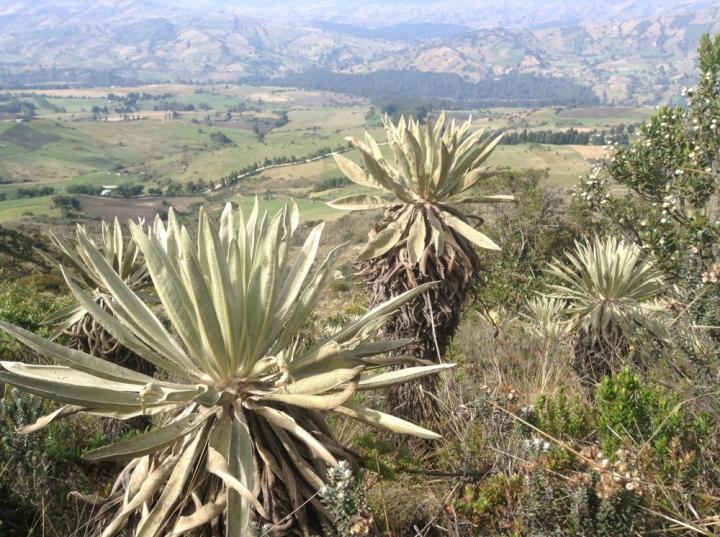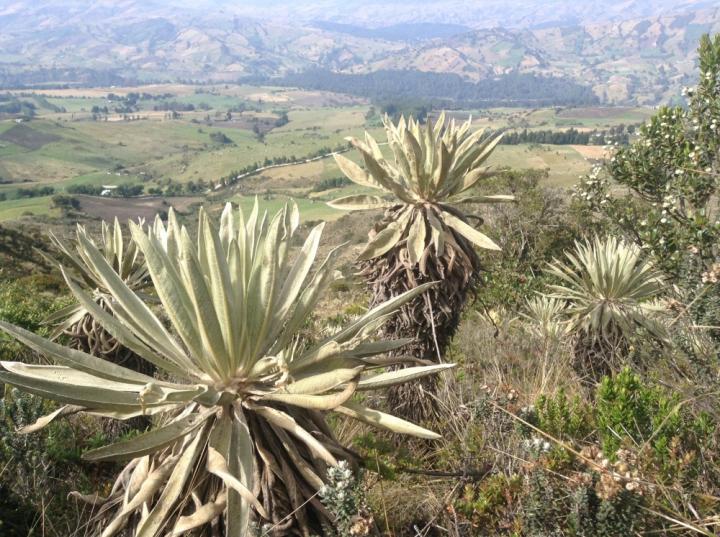
Credit: Frederico Padilla
With 72 species currently identified, Espeletia is a plant genus endemic to the paramo, a moist alpine biome unique to the northern Andes. This genus, which inhabits the world's most diverse high-altitude ecosystem, is considered an outstanding example of adaptive success.
Brazilian scientists investigated over Espeletia's diversity and geographic distribution in the paramo; the result, published in an August 2017 article on Scientific Reports, suggests that researchers might reconstitute more accurately the whole speciation process making use of a relatively unexplored bias in the study of evolutionary science: metabolomics.
Metabolomics refers to an area of study focusing on the chemical substances synthesized by a living organism — a byproduct of its metabolism — which is used to map chemical compounds inherent to a given species. In order to do so, a combination of techniques involving plant extracts, geographic data, and multivariate statistics is required. Studies of this kind are usually based on genomics, DNA marker analysis or morphological comparisons.
Researchers at the University of Sao Paulo's School of Pharmaceutical Sciences – Ribeirao Preto campus (FCFRP-USP), in Brazil, use metabolic fingerprinting for the first time to explain the evolutionary histories and biogeographic characteristics of Espeletia.
"Basically, we took the chemical compositions of the species of Espeletia and their metabolome and found a correlation with their geographic origins. Species present in the same locations display similar chemical profiles. The same link had already been found using molecular markers but on a larger geographic scale. This shows that the geography of the Andes not only determined the evolution of this plant group, and possibly of other plant groups in the region but also shaped the chemical compositions of these species," said Federico Padilla, one of the authors of the article.
Based on a study supported by Sao Paulo Research Foundation (FAPESP) through regular research grant, the article confirms a hypothesis on the origin and migration routes of Espeletia along the northern Andes proposed by researchers at the US National Museum of Natural History, part of the Smithsonian Institution, in the 1990s, which was hitherto partially supported by molecular markers.
According to this hypothesis, the original stock of Espeletia diversified when the first population of the genus started expanding in two directions from the western part of the Cordillera de Merida, the largest massif in Venezuela. One branch moved along the Venezuelan Andes, while the other moved west and southwest along the Colombian Andes and into northern Ecuador.
"Historically, this kind of analysis has been based on molecular markers. However, genetic analysis is unable to determine specific biogeographic trends with satisfactory precisions in groups that have evolved recently, such as the genus Espeletia, for which it merely identifies two groups, the Venezuelan and Colombian species, " Padilla said.
Metabolites data point evolutionary adaptation
The Smithsonian hypothesis was confirmed by an analysis of the secondary metabolites (i.e., the chemical compounds involved in plants' adaptations to the ecosystem), which pointed to patterns of geographic distributions and chemical diversifications in the Andean paramos.
"Each kind of marker has advantages and disadvantages," said Professor Fernando Batista da Costa , Padilla's supervisor and a co-author of the article published in Scientific Reports. "Unlike animals, plants can't move in order to adapt to this or that environment. Instead, they produce a vast array of chemical compounds that help them adapt to the place where they grow."
The rugged topography of the Andes makes the paramo a highly fragmented biome, biologically and geographically comparable to an archipelago in which "islands" of open grassland vegetation are separated by dense forests or deep valleys that prevent plant species from communicating with other paramos.
According to the article, this geographic isolation is a particularly influential factor for species with limited seed dispersal and a lack of long-distance pollinators, as is the case for Espeletia.
"We prove that their isolation favored allopatric speciation, meaning speciation occurring in separate regions because of geographic barriers. Darwin proposed this kind of speciation in his evolutionary theory as a result of his observations in the Galapagos Archipelago. He saw there that different islands had different species and that these species were related to each other," Batista da Costa said.
The researchers' analyses of the chemical compositions showed that species of Espeletia in different paramos differ not only genetically and morphologically but also chemically.
"In each paramo, most species accumulate different chemical compounds that may possibly be linked to their adaptation to that particular geographic area," Padilla said. "We demonstrate, using chemical evidence, that allopatric speciation occurred in these paramos and groups of species, as had been proposed in the 1990s."
Application of metabolomics in other areas
According to the researchers, this approach can be used to study practically all of a plant's metabolites at the same time.
"In classical phytochemistry, we studied one plant at a time and usually identified a few chemical substances," Padilla said. "With the new techniques and equipment, such as the liquid chromatography coupled with mass spectrometry that we used, we can now assemble 100 or more plant extracts, analyze them all at the same time, and obtain a data matrix potentially representing more than 1,000 chemical compounds."
The researchers stress that analogous models to that described in the article can be used to obtain metabolic fingerprints for other plants with the aim of analyzing their biogeographic and evolutionary histories.
"This new model can be used in agriculture, or for medicinal plants, or even by the police, for example, to identify the origin of marijuana consumed in a particular region," said Batista.
###
The study relates to FAPESP's Thematic Project "Morphoanatomical, metabolomic and molecular studies as subsidies to the systematic of Asteraceae species and access to their pharmacological potential".
Mauricio Diazgranados, a biologist at the Royal Botanic Gardens, Kew (United Kingdom), collaborated on the study supplying material collected during a period of more than three years from paramos in Venezuela and Colombia, for a project linked to his Ph.D. research on phylogeny and taxonomy.
About Sao Paulo Research Foundation (FAPESP)
The Sao Paulo Research Foundation (FAPESP) is a public institution with the mission of supporting scientific research in all fields of knowledge by awarding scholarships, fellowships and grants to investigators linked with higher education and research institutions in the State of Sao Paulo, Brazil. FAPESP is aware that the very best research can only be done by working with the best researchers internationally. Therefore, it has established partnerships with funding agencies, higher education, private companies, and research organizations in other countries known for the quality of their research and has been encouraging scientists funded by its grants to further develop their international collaboration. For more information: http://www.fapesp.br/en.
Media Contact
Heitor Shimizu
[email protected]
55-113-838-4223
@AgencyFAPESP
http://www.fapesp.br
Related Journal Article
http://dx.doi.org/10.1038/s41598-017-09431-7





